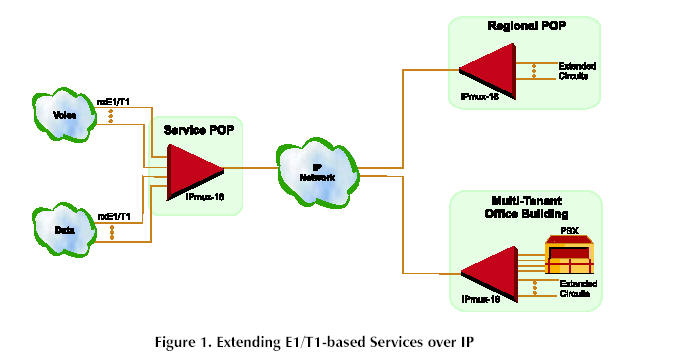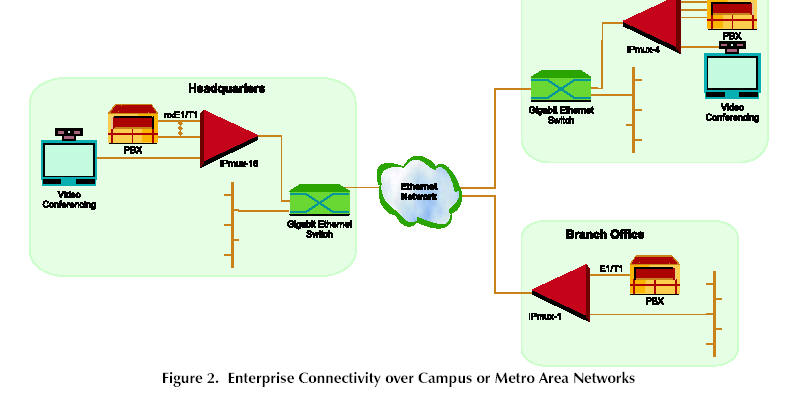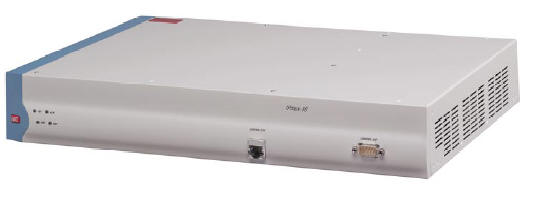|
FEATURES
-
IPmux-16 is a carrier class
TDMoIP gateway enabling E1/T1 circuit extension over IP networks
-
Supports synchronous TDM-based
services over IP and Ethernet networks
-
Multiplexes up to 16 E1/T1
circuits
-
Point-to-point and
point-to-multipoint applications based on IP addressing
-
Totally transparent to all
signaling protocols running over E1/T1
-
Extends either framed (full or
fractional) or unframed E1/T1 circuits
-
E1/T1 frames or bundles of
timeslots are transported over the network based on IP addressing
-
Integrated DS0 level grooming
and cross connect between E1 or T1 ports
-
10/100BaseT uplink to the
network
-
QoS support:
-
Low processing delay (under 2
msec)
-
Enables synchronous clock
distribution across IP-based networks
-
Compensates for packet delay
variation up to 32 msec for E1, 24 msec for T1
-
Redundant, hot-swappable power
supplies
-
Management interfaces: SNMP,
Telnet, TFTP and XMODEM with enhanced management tools and features
-
RADview Service Center
application enables provisioning and monitoring of TDMoIP services
-
Compact platform, 1.5U high,
19-inch rack compatible enclosure
SPECIFICATIONS
-
IPmux-16 provides a compact,
simple to configure, and easily scalable solution for transporting TDM
E1/T1 services over IP and Ethernet-based networks. IPmux-16 takes data
streams from up to 16 E1/T1 ports and converts them into packets for
transmission over the network. The addressing scheme of these frames is
IP. The frames are transmitted via IPmux-16's 10/100BaseT port to the
network. A second IPmux-16 at the remote location converts the IP packets
back to TDM traffic.
-
IPmux-16 is a standard IP
device, supporting ICMP (ping), ARP, next hop and default gateway
capabilities.
-
-
IPmux-16 features a dry contact
alarm port (with a DB-9 connector) which allows the device to send/receive
alarms by opening/closing the contact between the connector's pins.
PERFORMANCE
QoS SUPPORT
-
The user can configure the ToS
(Type of Service) of the outgoing IP frames. This allows an en-route
Layer-3 router or switch, which supports ToS (or Diffserv), to give higher
priority to IPmux-16 traffic for delay-sensitive applications.
OPERATION MODES
TIMING
ETHERNET MODULE
-
Each Ethernet module includes a
single standard 10/100BaseT port with auto-negotiation support, which
provides the uplink to the network. If auto-negotiation is disabled,
IPmux-16 can be configured to any of the following:
-
100BaseT - full duplex
-
100BaseT - half duplex
-
10BaseT - full duplex
-
10BaseT - half duplex.
E1 AND T1 MODULES
POWER SUPPLY
DIAGNOSTICS & MANAGEMENT
-
IPmux-16 supports E1/T1 remote
loop and local loop testing. End-to-end alarm generation and end-to-end
AIS indication are also provided. In the event that a local E1/T1 port
receives an AIS, it is passed to the remote port via the Ethernet/IP
network. If a local Ethernet port is not connected, an AIS indication will
be generated both in the local and the remote devices.
-
On the E1/T1 ports, SES and UAS
statistics are collected in 15-minute intervals and are stored for 24
hours (96 intervals). E1/T1 physical layer alarms (LOS, AIS, LOF, LCV) are
also supported. ? IPmux-16 monitors LAN and IP layer network condition
statistics, such as packet loss and packet delay variation (jitter). The
events are stored in log files and SNMP traps are generated.
-
Software download is supported
via the local terminal using XMODEM, or remotely, using TFTP. After
downloading a new version of software, IPmux-16 automatically saves the
previous version in non-volatile memory for backup purposes. Similarly,
copies of the configuration file may be downloaded and uploaded to a
remote workstation for backup and restore purposes. ? IPmux-16 can be
configured and monitored locally via an ASCII terminal, or remotely via
Telnet or RADview.
-
RADview-HPOV, RAD's SNMP-based
network management system, provides a user-friendly graphical display that
allows monitoring and configuring of multiple IPmux devices. Fault
isolation, statistics and events gathering are available. RADview-HPOV can
hold a complete predefined IPmux-16 configuration to shorten and simplify
field installation.

ordering
IPMUX-16/48
IPMUX-16/48/R
IPMUX-16/AC
IPMUX-16/AC/R
IPMUX-16/E1/48/R
IPMUX-16/E1/AC/R
IPMUX-16/PS/AC
IPMUX-16/PS/DC
IPMUX-16/T1/48
IPMUX-16/T1/48/R
IPMUX-16/T1/AC
IPMUX-16/T1/AC/R
APPLICATIONS


|

